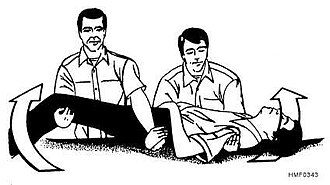Difference between revisions of "AY Honors/First aid/Two person carry/es"
(Created page with "Libro de Respuestas de Especialidades JA/Primeros Auxilios/Traslado por Dos Personas") |
(Created page with "</noinclude> thumb|300px|right|Traslado con dos personas") |
||
| Line 1: | Line 1: | ||
<noinclude></noinclude> | <noinclude></noinclude> | ||
| − | [[Image:Two-person_arm_carry.jpg|thumb|300px|right| | + | [[Image:Two-person_arm_carry.jpg|thumb|300px|right|Traslado con dos personas]] |
Manual carries are tiring for the bearer(s) and involve the risk of increasing the severity of the casualty’s injury. In some instances, however, they are essential to save the casualty’s life. Although manual carries are accomplished by one or two bearers, the two-man carries are used whenever possible. They provide more comfort to the casualty, are less likely to aggravate his injuries, and are also less tiring for the bearers, thus enabling them to carry him farther. | Manual carries are tiring for the bearer(s) and involve the risk of increasing the severity of the casualty’s injury. In some instances, however, they are essential to save the casualty’s life. Although manual carries are accomplished by one or two bearers, the two-man carries are used whenever possible. They provide more comfort to the casualty, are less likely to aggravate his injuries, and are also less tiring for the bearers, thus enabling them to carry him farther. | ||
Revision as of 02:42, 24 April 2015
Manual carries are tiring for the bearer(s) and involve the risk of increasing the severity of the casualty’s injury. In some instances, however, they are essential to save the casualty’s life. Although manual carries are accomplished by one or two bearers, the two-man carries are used whenever possible. They provide more comfort to the casualty, are less likely to aggravate his injuries, and are also less tiring for the bearers, thus enabling them to carry him farther.
One two-person carry that can be used in emergencies is shown here. Two rescuers position themselves beside the casualty, on the same side, one at the level of the chest and the other at the thighs. The rescuers interlock adjacent arms as shown, while they support the victim at the shoulders and knees. In unison, they lift the victim and roll his front toward theirs. This carry must not be used to move seriously injured persons.

